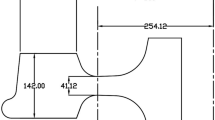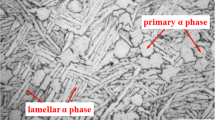Abstract
The present research aims to investigate general laws of three-pass roll forming of steel wheel rim by finite element simulation. Firstly, finite element models of the rolling process were built on ABAQUS. To ensure the validity of models, some important settings as multistep construction, flexible boundary conditions of side rolls and nonlinear loading curves were considered, which provide the basis for high-accuracy numerical simulation of rim forming. Based on the results of simulation, each pass of the rim forming process was then analyzed. Especially, the investigations of wall thickness distribution and equivalent plastic strain on formed wheel rim are conducted, from which the role of three rolling passes and characteristics of rim forming can be summarized. Moreover, experiment results verified the reliability of finite element model. Subsequently, for analyzing the problems of welding-line cracking, model of flaring dies with various flaring angles were tried in simulations to discuss their influences on forming results of the wheel rim.
Similar content being viewed by others
References
Yoon, J. S., Son, S. E., Song, W. J., Kim, J., and Kang, B. S., “Study on Flexibly-Reconfigurable Roll Forming Process for Multi-Curved Surface of Sheet Metal,” Int. J. Precis. Eng. Manuf., vol. 15, no. 6, pp. 1069–1074, 2014.
Cai, Z. Y., Li, L. L., Wang, M., and Li, M. Z., “Process Design and Longitudinal Deformation Prediction in Continuous Sheet Metal Roll Forming for Three-Dimensional Surface,” Int. J. Precis. Eng. Manuf., vol. 15, no. 9, pp. 1889–1895, 2014.
Cai, Z. Y., Lan, Y. W., Li, M. Z., Hu, Z. Q., and Wang, M., “Continuous Sheet Metal Forming for Doubly Curved Surface Parts,” Int. J. Precis. Eng. Manuf., vol. 13, no. 11, pp. 1997–2003, 2012.
Shim, D. S. and Yang, D. Y., “Multi-Stage Forming using Optimized Preform in the Line Array Roll Set Process and Its Industrial Application,” Int. J. Precis. Eng. Manuf., vol. 15, no. 10, pp. 2085–2092, 2014.
Shim, D. S., Yang, D. Y., Lee, D. J., and Han, M. S., “Development of Process Design Program for Manufacture of Desired Shapes using Line Array Roll Set (LARS) Process,” Int. J. Precis. Eng. Manuf., vol. 14, no. 8, pp. 1501–1504, 2013.
Shim, D. S., Yang, D. Y., Chung, S. W., and Han, M. S., “Optimization of Forming Steps in the Incremental Forming of Twisted Shapes using a Line Array Roll Set (LARS),” Int. J. Precis. Eng. Manuf., vol. 11, no. 5, pp. 715–723, 2010.
Sweeney, K. and Grunewald, U., “The Application of Roll Forming for Automotive Structural Parts,” Journal of Materials Processing Technology, vol. 132, no. 1, pp. 9–15, 2003.
Lindgren, M., “Cold Roll Forming of a U-Channel Made of High Strength Steel,” Journal of Materials Processing Technology, vol. 186, no. 1, pp. 77–81, 2007.
Liu, C., Zhou, Y., and Lu, W., “Numerical Simulation of Roll-Forming by B-Spline Finite Strip Method,” Journal of Materials Processing Technology, vol. 60, no. 1, pp. 215–218, 1996.
Han, Z. W., Liu, C., Lu, W. P., and Ren, L. Q., “Simulation of a Multi-Stand Roll-Forming Process for Thick Channel Section,” Journal of Materials Processing Technology, vol. 127, no. 3, pp. 382–387, 2002.
Brunet, M., Mguil, S., and Pol, P., “Modelling of a Roll-Forming Process with a Combined 2D and 3D FEM Code,” Journal of Materials Processing Technology, Vols. 80–81, pp. 213–219, 1998.
Heislitz, F., Livatyali, H., Ahmetoglu, M. A., Kinzel, G. L., and Altan, T., “Simulation of Roll Forming Process with the 3-D FEM Code Pam-Stamp,” Journal of Materials Processing Technology, vol. 59, no. 1, pp. 59–67, 1996.
Zeng, J., Liu, Z., and Champliaud, H., “FEM Dynamic Simulation and Analysis of the Roll-Bending Process for Forming a Conical Tube,” Journal of Materials Processing Technology, vol. 198, no. 1, pp. 330–343, 2008.
Bui, Q. V. and Ponthot, J. P., “Numerical Simulation of Cold Roll-Forming Processes,” Journal of Materials Processing Technology, vol. 202, no. 1, pp. 275–282, 2008.
Cha, W. G. and Kim, N., “Study on Twisting and Bowing of Roll Formed Products Made of High Strength Steel,” Int. J. Precis. Eng. Manuf., vol. 14, no. 9, pp. 1527–1533, 2013.
Park, H. S. and Nguyen, T. T., “Optimization of Roll Forming Process with Evolutionary Algorithm for Green Product,” Int. J. Precis. Eng. Manuf., vol. 14, no. 12, pp. 2127–2135, 2013.
Simulia, S. “ABAQUS/CAE Analysis User’s Manual, V 6.5,” 2005.
Chung, W., Cho, J., and Belytschko, T., “On the Dynamic Effects of Explicit FEM in Sheet Metal Forming Analysis,” Engineering Computations, vol. 15, no. 6, pp. 750–776, 1998.
Author information
Authors and Affiliations
Corresponding author
Rights and permissions
About this article
Cite this article
Fang, G., Gao, WR. & Zhang, XG. Finite element simulation and experiment verification of rolling forming for the truck wheel rim. Int. J. Precis. Eng. Manuf. 16, 1509–1515 (2015). https://doi.org/10.1007/s12541-015-0200-4
Received:
Revised:
Accepted:
Published:
Issue Date:
DOI: https://doi.org/10.1007/s12541-015-0200-4




